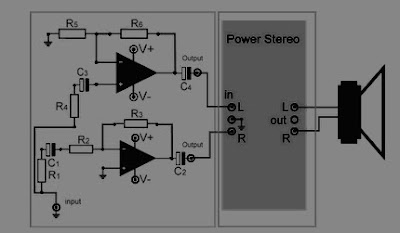Rangkaian Power Amplifier BTL
Wednesday, March 28, 2012 by skemarangkaian
 |
| Gambar Rangkaian Power Amplifier BTL |
Audio amplifiers operate either in a BTL (bridged) or single-ended ("normal") configuration. In the single-ended setup, the output lead goes to the "hot" or "+" side of the load (speaker or speaker box since we are talking audio) and the "-" or "negative" side of the load is tied to a common ground shared with the amplifier. In the BTL configuration, one amp is connected to the "+" side of the speaker (load) and a second amp is connected to the "-" side of the load. For this to work, the output signal from the second amplifier must be a "mirror image" (identical in every respect, but 180 degrees out of phase) of the output from the first amp. The BTL configuration is most often seen in low-voltage, battery-powered applications (like cell phones or "walkman" type personal tape or cd players etc) or in automotive applications over about 10 watts per channel.
In the BTL configuration, each amp drives half the load impedance. With the signals being out of phase, the voltage swing across the load appears to be doubled, and with each amp driving half the impedance the current is doubled. In theory the bridged pair will produce 4 times the power into the load that either amp acting alone could provide. In reality it seldom works that well.
This is an power amplifier circuit of a BTL system, which comprises a first op-amp chip which outputs an output signal having a same phase as an input signal input to a signal input terminal, a second operational amplifier which outputs an output signal having an opposite phase to the input signal, a voltage divider which generates a midpoint voltage of the input signal, a first resistor connected between an output terminal and a negative phase input terminal of the first operational amplifier, second and third resistors connected in series between the negative phase input terminals of the first and second operational amplifiers, a fourth resistor connected between an output terminal and the negative phase input terminal of the second operational amplifier, and an impedance converter connected between a midpoint voltage node of the voltage divider and a series-connection node of the second and third resistors. (end of abstract)

List Componet:
R1, R2,R3, R4, R6..................... 10kOhm.
R3............................................. 20kOhm.
C1, C2, C3, C4........................... 10µF.
Catu daya (VCC) ±12 V.